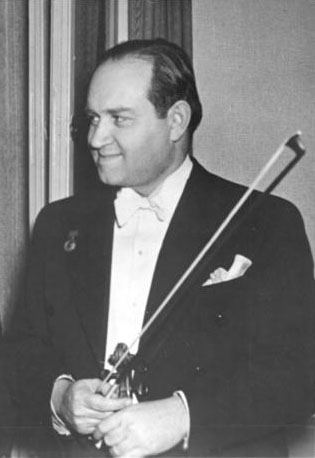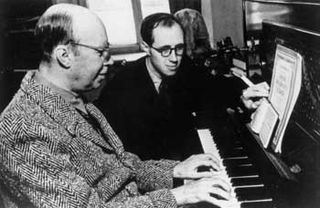Structure
The work is about 30 minutes long and is in four movements of roughly equal length:
- Andante assai (F minor)
- Allegro brusco (C major)
- Andante (F major)
- Allegrissimo - Andante assai, come prima (F major → F minor)
Prokofiev had described the slithering violin scales at the end of the 1st and 4th movements as 'wind passing through a graveyard'.
The work was premiered by David Oistrakh and Lev Oborin on October 23, 1946, under the personal coaching of the composer. During rehearsals, Oborin played a certain passage, marked forte, too gently for Prokofiev's liking, who insisted it should be more aggressive. Oborin replied that he was afraid of drowning out the violin, but Prokofiev said "It should sound in such a way that people should jump in their seat, and people will say 'Is he out of his mind?'". [1]
The first and third movements of the sonata were played at Prokofiev's funeral by Oistrakh and Samuil Feinberg. [2]

Sergei Sergeyevich Prokofiev was a Russian composer, pianist, and conductor who later worked in the Soviet Union. As the creator of acknowledged masterpieces across numerous music genres, he is regarded as one of the major composers of the 20th century. His works include such widely heard pieces as the March from The Love for Three Oranges, the suite Lieutenant Kijé, the ballet Romeo and Juliet—from which "Dance of the Knights" is taken—and Peter and the Wolf. Of the established forms and genres in which he worked, he created—excluding juvenilia—seven completed operas, seven symphonies, eight ballets, five piano concertos, two violin concertos, a cello concerto, a symphony-concerto for cello and orchestra, and nine completed piano sonatas.

Sonata, in music, literally means a piece played as opposed to a cantata, a piece sung. The term evolved through the history of music, designating a variety of forms until the Classical era, when it took on increasing importance. Sonata is a vague term, with varying meanings depending on the context and time period. By the early 19th century, it came to represent a principle of composing large-scale works. It was applied to most instrumental genres and regarded—alongside the fugue—as one of two fundamental methods of organizing, interpreting and analyzing concert music. Though the musical style of sonatas has changed since the Classical era, most 20th- and 21st-century sonatas still maintain the same structure.

David Fyodorovich Oistrakh, was a Soviet classical violinist, violist and conductor.

Nikolai Karlovich Medtner was a Russian composer and virtuoso pianist. After a period of comparative obscurity in the 25 years immediately after his death, he is now becoming recognized as one of the most significant Russian composers for the piano.
Sergei Prokofiev began his Violin Concerto No. 1 in D major, Op. 19, as a concertino in 1915 but soon abandoned it to work on his opera The Gambler. He returned to the concerto in the summer of 1917. It premiered on October 18, 1923 at the Paris Opera with Marcel Darrieux playing the violin part and the Paris Opera Orchestra conducted by Serge Koussevitzky. Igor Stravinsky made his debut as conductor at the same concert, conducting the first performance of his own Octet for Wind Instruments.

Lev Nikolayevich Oborin was a Soviet and Russian pianist, composer and pedagogue. He was the winner of the first International Chopin Piano Competition in 1927.

The Violin Concerto No. 2 in G minor, Op. 63, written in 1935 by Sergei Prokofiev, is a work in three movements:
- Allegro moderato
- Andante assai
- Allegro, ben marcato
Sergei Prokofiev's Violin Sonata No. 2 in D Major, Op. 94a, was based on the composer's own Flute Sonata in D, Op. 94, written in 1942 but arranged for violin in 1943 when Prokofiev was living in Perm in the Ural Mountains, a remote shelter for Soviet artists during the Second World War. Prokofiev transformed the work into a violin sonata at the prompting of his close friend, the violinist David Oistrakh. It was premiered on 17 June 1944 by David Oistrakh and Lev Oborin.

The Piano Trio No. 2 in E minor, Op. 67, is a piece for violin, cello and piano by the Russian composer Dmitri Shostakovich, started in late 1943 and completed in August the following year. It was premiered on 14 November 1944. The piece was dedicated to his close friend Ivan Sollertinsky, whose death in February 1944 affected Shostakovich profoundly.
An organ concerto is a piece of music, an instrumental concerto for a pipe organ soloist with an orchestra. The form first evolved in the 18th century, when composers including Antonio Vivaldi, George Frideric Handel and Johann Sebastian Bach wrote organ concertos with small orchestras, and with solo parts which rarely call for the organ pedal board. During the Classical period the organ concerto became popular in many places, especially in Bavaria, Austria and Bohemia, reaching a position of being almost an integral part of the church music tradition of jubilus character. From the Romantic era fewer works are known. Finally, there are some 20th- and 21st-century examples, of which the concerto by Francis Poulenc has entered the basic repertoire, and is quite frequently played.
The Flute Sonata in D, Op. 94, is a musical work composed by Sergei Prokofiev in 1943. It was initially composed for flute and piano, and was later transcribed for violin as Op. 94a, both versions have been recorded several times. The piece contains four different movements.
Sergei Prokofiev's Piano Sonata No. 4 in C minor, Op. 29, subtitled D’après des vieux cahiers, or After Old Notebooks, was composed in 1917 and premiered on April 17 the next year by the composer himself in Petrograd. The work was dedicated to Prokofiev's late friend Maximilian Schmidthof, whose suicide in 1913 had shocked and saddened the composer.

Dmitri Shostakovich composed his Sonata for Violin and Piano in G major, Op. 134 in the autumn of 1968 in Moscow, completing it on October 23. It is set in three movements and lasts approximately 31 minutes. It is dedicated to the violinist David Oistrakh, who premiered the work on May 3, 1969 in the Large Hall of the Moscow Conservatory.
Sviatoslav Nikolayevich Knushevitsky was a Soviet-Russian classical cellist. He was particularly noted for his partnership with the violinist David Oistrakh and the pianist Lev Oborin in a renowned piano trio from 1940 until his death. After Mstislav Rostropovich and Daniil Shafran, he is spoken of as one of the pre-eminent Russian cellists of the 20th century.
Aram Khachaturian wrote his Cello Concerto in E minor in 1946 for Sviatoslav Knushevitsky. It was the last of the three concertos he wrote for the individual members of a renowned Soviet piano trio that performed together from 1941 until 1963. The others were: the Piano Concerto for Lev Oborin (1936); and the Violin Concerto for David Oistrakh (1940).

The Cello Sonata in C major, Op. 119, was composed by Sergei Prokofiev in 1949. The year before, Prokofiev was accused of formalism by the Zhdanov Decree and much of his music was banned. However, he continued to compose music, though he was not sure if his new works would ever be performed in public.
Tales of an Old Grandmother, Op. 31 is a set of four piano pieces by Sergei Prokofiev. It was composed in 1918 and premiered by the composer himself on January 7 the following year in New York City, probably at Aeolian Hall. It has an approximate duration of ten minutes and it was first published by Gutheil in Moscow in 1922. It was composed during Prokofiev's exile in the United States after the outbreak of the Russian Revolution. An arrangement for orchestra also exists.

Sergei Prokofiev began composing his Sonata for Solo Cello, Op. 134, in 1952. The sonata was intended to be written in four movements, but as it was one of seven compositions which the composer was writing during this time, only the beginning of the first movement was completed before Prokofiev's death in March 1953.

The Piano Quartets, WoO 36, by Ludwig van Beethoven are a set of three piano quartets, completed in 1785 when the composer was aged 14. They are scored for piano, violin, viola and cello. He composed a quartet in C major, another in E-flat major, and a third in D major. They were first published posthumously in 1828, however numbered in a different order: Piano Quartet No. 1 in E-flat major, Piano Quartet No. 2 in D major, and Piano Quartet No. 3 in C major.









